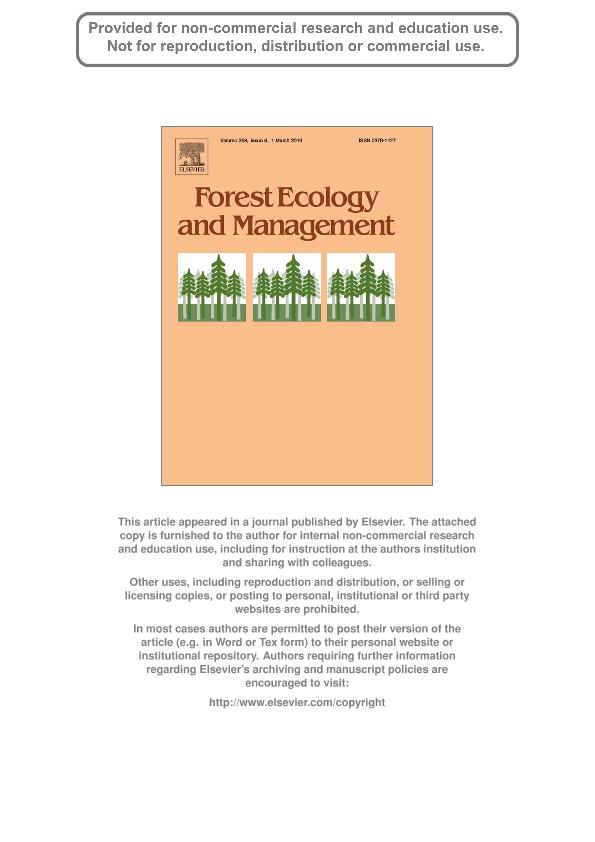Mostrar el registro sencillo del ítem
dc.contributor.author
Gargaglione, Veronica Beatriz

dc.contributor.author
Peri, Pablo Luis

dc.contributor.author
Rubio, Gerardo

dc.date.available
2018-07-30T21:50:35Z
dc.date.issued
2010-03
dc.identifier.citation
Gargaglione, Veronica Beatriz; Peri, Pablo Luis; Rubio, Gerardo; Allometric relations for biomass partitioning of Nothofagus antarctica trees of different crown classes growing in a site quality gradient; Elsevier Science; Forest Ecology and Management; 259; 6; 3-2010; 1118-1126
dc.identifier.issn
0378-1127
dc.identifier.uri
http://hdl.handle.net/11336/53545
dc.description.abstract
Data on tree biomass are essential for understanding the forest carbon cycle and plant adaptations to the environment. We determined biomass accumulation and allometric relationships in the partitioning of biomass between aboveground woody biomass, leaves and roots in Nothofagus antarctica. We measured above- and belowground biomass of N. antarctica trees across different ages (5-220 years) and crown classes (dominant, codominant, intermediate and suppressed) in three site qualities. The biomass allocation patterns were studied by fitting allometric functions in biomass partitioning between leaves (ML), stem and branches (MS) and roots (MR). These patterns were tested for all pooled data and according to site quality and crown classes. Biomass accumulation varied with crown class and site quality. The root component represented 26-72% of the total biomass depending on age and site. N. antarctica scaling exponents for the relationships ML vs. MS, MA vs. MR, and MS vs. MR were close to those predicted by the allometric biomass partitioning model. However, when biomass allocation was analyzed by site quality the scaling exponents varied following the optimal partitioning theory which states that plants should allocate more biomass to the part of the plant that acquires the most limiting resource. In contrast, the crown class effect on biomass partitioning was almost negligible. In conclusion, to obtain accurate estimations of biomass in N. antarctica trees the allometric approach appears as an useful tool but the site quality should be taken into consideration.
dc.format
application/pdf
dc.language.iso
eng
dc.publisher
Elsevier Science

dc.rights
info:eu-repo/semantics/openAccess
dc.rights.uri
https://creativecommons.org/licenses/by-nc-sa/2.5/ar/
dc.subject
Allometry
dc.subject
Biomass Allocation
dc.subject
Biomass Partitioning
dc.subject
Nothofagus
dc.subject.classification
Agricultura

dc.subject.classification
Agricultura, Silvicultura y Pesca

dc.subject.classification
CIENCIAS AGRÍCOLAS

dc.title
Allometric relations for biomass partitioning of Nothofagus antarctica trees of different crown classes growing in a site quality gradient
dc.type
info:eu-repo/semantics/article
dc.type
info:ar-repo/semantics/artículo
dc.type
info:eu-repo/semantics/publishedVersion
dc.date.updated
2018-07-30T15:41:25Z
dc.journal.volume
259
dc.journal.number
6
dc.journal.pagination
1118-1126
dc.journal.pais
Países Bajos

dc.journal.ciudad
Amsterdam
dc.description.fil
Fil: Gargaglione, Veronica Beatriz. Instituto Nacional de Tecnología Agropecuaria; Argentina. Consejo Nacional de Investigaciones Científicas y Técnicas; Argentina
dc.description.fil
Fil: Peri, Pablo Luis. Instituto Nacional de Tecnología Agropecuaria; Argentina. Consejo Nacional de Investigaciones Científicas y Técnicas; Argentina. Universidad Nacional de la Patagonia Austral; Argentina
dc.description.fil
Fil: Rubio, Gerardo. Consejo Nacional de Investigaciones Científicas y Técnicas; Argentina. Universidad de Buenos Aires; Argentina
dc.journal.title
Forest Ecology and Management

dc.relation.alternativeid
info:eu-repo/semantics/altIdentifier/doi/http://dx.doi.org/10.1016/j.foreco.2009.12.025
dc.relation.alternativeid
info:eu-repo/semantics/altIdentifier/url/https://www.sciencedirect.com/science/article/pii/S037811270900913X
Archivos asociados
